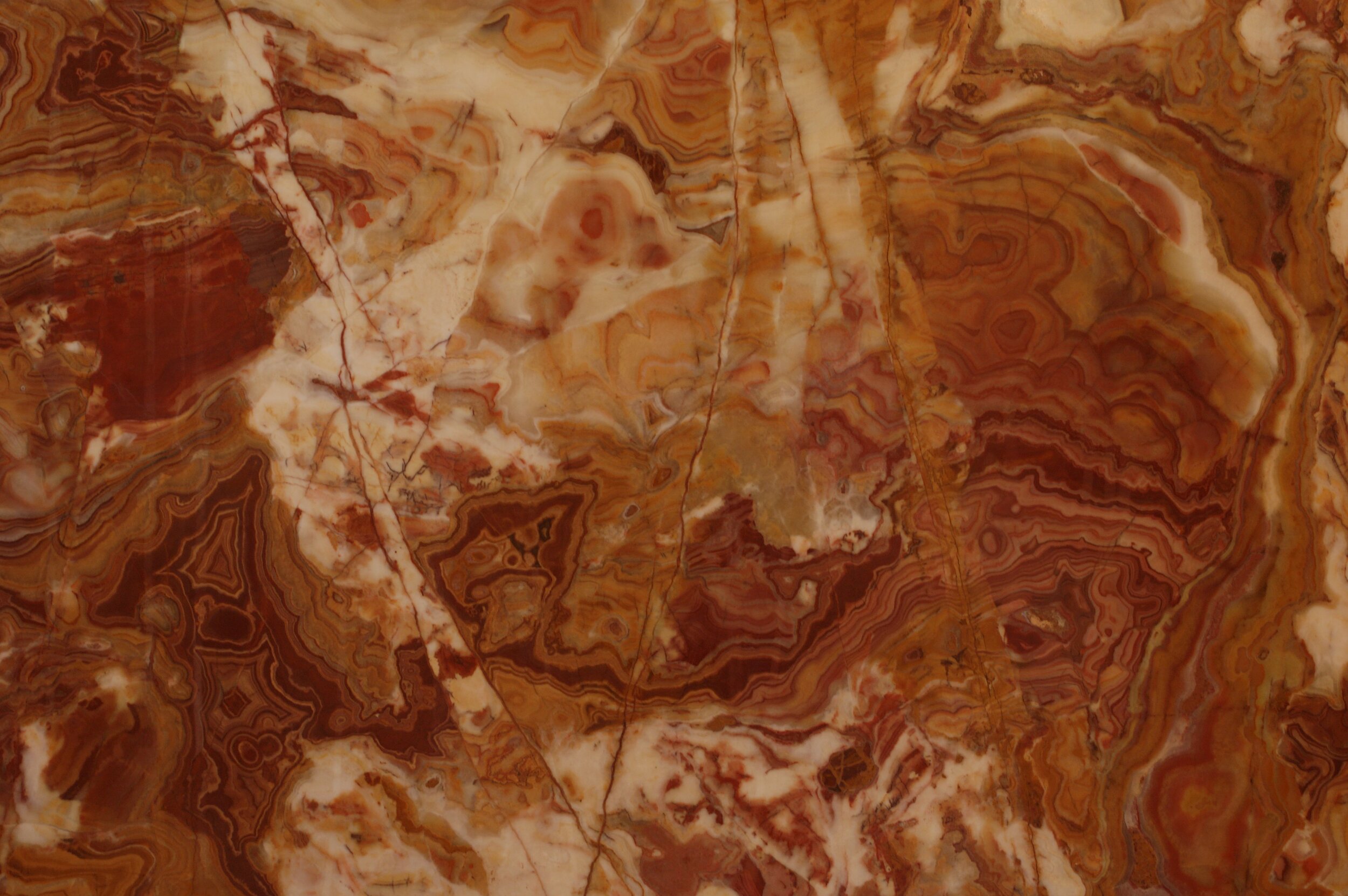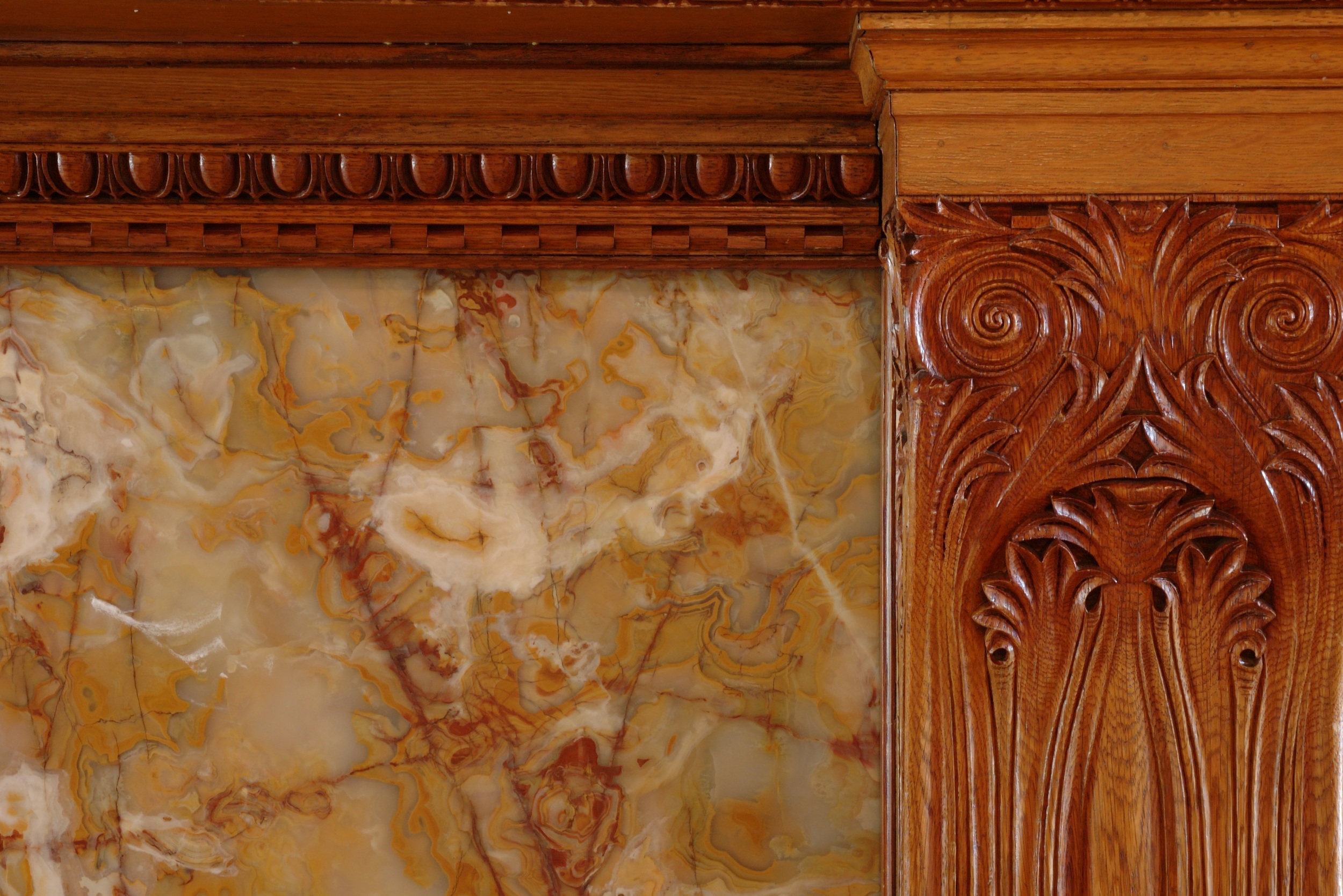Bohemian-American Marble Workers
Within thick exterior walls of glacial boulders is a symphony of expertly crafted colorful marbles, fossils and onyx from around the world that anchor and inspire architect H.H. Richardson’s interior design. Colors formed by metallic oxides vary in translucency, opacity and shade “from the dark green to the apple green and from the intense red to the lightest rose tint.” Mineral colors are the starting point for each room’s color scheme, and the fluid and angular patterns in stone offer interesting lessons in geology. In fact, its suppliers S. Klaber & Co. contributed a large mineralogical collection to the New York State Museum.[1]
Mexican onyx
The flowing patterns of Mexican onyx in the Great Hall were created by the slow settling of minerals at the mouth of a spring in Puebla, Mexico. “Cut in the direction of their planes of stratification, the shades appear in the form of clouds, flames and stains of all dimensions.”[2] The Rosso d’Africa marble of the Bow Parlor is a type of breccia (“rubble”) with broken fragments of red rock cemented together in a fine matrix. In the Siennese “Rose Aurore” marble in the Summer Parlor---the color of the sunrise--the patterns are angular or broken, revealing great shifts in the Earth’s crust. Inside and outside the stones tell the story of a planet shaped by water, minerals, natural forces, and time.
Great forces of a completely different sort made possible such a varied and diverse assemblage of beautiful stone from distant countries. These magnificent stone features were sourced by a talented art worker named Simon Klaber who grew up in the Jewish Quarter in Prague, one of Europe’s oldest recorded Jewish communities, at a time when Jews were not treated as full citizens. [3] In early 19th-century Prague (then a part of Bohemia), Simon Klaber and his family confronted laws that limited property ownership and professional recognition purely on account of their religion. But in America, “founded on the authority of the people, without an appeal to any scriptural warrant,… the Jew had been guaranteed political, juridical and economic equality…. He was not excluded from non-Jewish craftsmen’s guilds,… had an unrestricted opportunity to secure training as an artist or artisan, and could cater to a market which was essentially non-Jewish.” [4]
Advertisement in The Jewish Messenger, Jan 14, 1859.
Simon Klaber (1824-1899) immigrated to New York in 1845 at age 21, filed for citizenship, renounced allegiance to the Emperor of Austria, and found work as a stonecutter in a West Side marble yard. He “rapidly advanced to a position of responsibility” and formed a large circle of friends. Klaber founded and led a Bohemian-Jewish mutual aid society, Boehmische Bruder (Bohemian Brothers) in 1846.[5] At age 25 in 1849, he established his own marble works, S. Klaber & Co., and soon began advertising in The American Isrealite (Cincinnati) and The Jewish Messenger (New York City). [6]
geni.com
These early investments in what seems to have been a small business of marble mantels, headstones and monuments would eventually blossom into a national enterprise. S. Klaber & Co. would become well known across the country as importers and workers in rich marbles, Mexican onyx, and architectural and ornamental bronze for famous designers like H.H. Richardson and Tiffany & Co. “Mr. K. superintends the manufacture of every article.” [7]
As Jewish people across Europe fought for emancipation in the revolutions of 1848, giving rise to the mass “auf nach Americka” (On to America) movement, Klaber family members followed Simon to the U.S. from Prague and joined the business of transforming marble, onyx, metals and precious stones into jewels and works of art. A brother Adolph (born Abraham) opened his own marble works in New York City and often advertised with Simon. A son James patented machines for dressing marble slabs. Two other family members and business partners were also jewelers and watchmakers. [8]
Stonehurst’s architect H.H. Richardson may have first worked with Simon Klaber in the 1870s in connection with the New York State Capitol Building. Richardson’s Senate Chamber designed with the help of his assistant Stanford White and featuring an abundance of marbles and onyx supplied and worked by S. Klaber & Co. has been described as the most beautiful room in America. “The whole room is to be a piece of color,” White wrote to Augustus Saint-Gaudens. [9] In this public commission for a seat of government, Richardson partnered with architect Leopold Eidlitz who also had grown up in the Jewish Quarter of Prague in the early 19th century and trained in Germany. Now considered America’s first prominent Jewish architect, Eidlitz was a nearly exact contemporary of Simon Klaber who left Prague for New York at roughly the same time. [10]
Klaber set up a second factory in Carlstadt, New Jersey, a town founded in 1851 by like-minded German-speaking workers who had fled to the US seeking political liberty during the 1848 revolutions. S. Klaber & Co. was one of the primary manufacturers in this “beautiful little German village on the hill” with a view of the Statue of Liberty. The Carlstadt factory included a foundry as well as marble works and often worked for Tiffany & Co. [11] It also cast sculpture in bronze for independent artists such as Solon Borglum, Abastinia St. Legere Eberle, Leonard Volk and Victor Brenner. Appropriately, Eberle’s sculptural figures bearing the stamp S. Klaber & Co. capture scenes of immigrant life on New York’s Lower East Side. [12]
Abraham Lincoln was another reoccurring subject in the S. Klaber & Co. foundry. Victor Brenner, a little known Jewish artist from Lithuania, must have scrimped and saved to hire the Klabers to cast his bas relief of Abraham Lincoln in bronze. The now iconic portrait that Brenner displayed in his humble Lower East Side studio caught the eye of President Theodore Roosevelt. Today, Lincoln’s profile--sculpted and initially cast by immigrants from Lithuania and Prague--is the most reproduced work of art in the world in the form of the Lincoln penny. [13]
For a modern look at quarrying and marble working in Mexico, watch this video…
References
1. University of the State of New York, New York State Museum Forty-Third Annual Report of the Regents for the Year 1889 (Albany, NY: James B. Lyon, 1890), 13-14, 31. S. Klaber & Co. donated a collection of “the most valued and best known marbles and serpentines for ornamental work from Algeria, Spain, France, Belgium, Great Britain, and our own country.”
2. Mariano Barcena, “The Rocks Known as Mexican Onyx,” Proceedings of the Academy of Natural Sciences of Philadelphia, vol. 28 (1876), pp. 166-168. A catalogue of the 1876 International Exhibition in Philadelphia 1876 includes Mexican marble from the state of Puebis displayed by Julian Gutierrez & Co., but not S. Klaber & Co. In the 1893 World’s Columbian Exposition, S. Klaber & Co. won an honorable mention for their display of “Mexican onyx and other marble and bronze ornamentations.” The Metal Industry, April 1909. World’s Columbian Exposition Official Catalogue, 1893.
3. Like so many subcontractors whose names are often omitted from the records, the contributions of S. Klaber & Co. were well known in their time but are surprisingly unrecognized today. Fortunately, the Paines held on to their “schedule of marbles” which identifies S. Klaber & Co. as the supplier of these important architectural components of Richardson’s interiors.
5. The Bohemian Brothers was later known as the Vereinigte Bruder. Other organizational affiliations include the Friedens Verein, the General Society of Mechanics and Traders, the Society for Ethical Culture and the King Solomon Lodge of the Order of Free Masons. “Simon Klaber,” New York Tribune, Sept 19, 1899.
6. Miloslav Rechcigl, Jr. “Bohemian and Czech Jews in American History.” Kosmas. Czechoslovak and Central European Journal 26, No. 1 (Fall 2012), pp. 70-112. Klaber advertised in The American Isrealite out of Cincinnati from 1854 to 1858 and in The Jewish Messenger from 1857 to 1896. These were two of the three primary newspapers run by and for Jewish-Americans. Isaac Markens, “Lincoln and the Jews,” America Jewish Historical Society Journal (1909) p. 109.
7. Simon Klaber advertisement in American Artisan (New York, NY), Jan 22, 1853.
8. We are most grateful to a descendant for sharing her family research on the Klabers. See ancestry.com and geni.com. Simon Klaber and his father Seligman were in the marble business at 160 Allen St., in the 1850s. Seligman was buried in the Bohemian-Jewish section of Cypress Hills Cemetery NY in 1860. Klaber’s son-in-law and contemporary Adolph Frankfield had his own business as a jeweler and watchmaker, but was also a partner in S. Klaber & Co. in the 1870s. (New York Daily Herald, 16 Dec 1876 and 17 Jan 1877) When Adolph Frankfield retired in 1882, Klaber’s son James became a full partner. (New York Times, 18 Jan 1882, p. 6) Klaber’s other son Maurice was initially a jeweler working with Adolph Frankfield, but joined S. Klaber & Co. in the marble business in the mid 1880s. James Klaber holds US patent 155734A of 1874.
9. “Annual Report of the State Treasurer.” Documents of the Senate of the State of New York (Albany, NY, 1885), p, 78. James F. O’Gorman, Henry Hobson Richardson and His Office: Selected Drawings (Cambridge: Harvard University Library, 1974), 121-124. Margaret Henderson Floyd, Henry Hobson Richardson: A Genius for Architecture (New York: The Monacelli Press, 1997), 86-104.
10. Eidlitz immigrated to New York just two years before Klaber, and his brother Marc was one of New York’s leading building contractors. Kathryn E. Holliday, Leopold Eidlitz: Architecture and Idealism in the Gilded Age, New York: WW. Norton & Co., 2008. 22-24. Kenneth Franklin Jacobs, “Leopold Eidlitz: Becoming an American Architect” (2005) Publicly Accessible Penn Dissertations. 1178.
11. The Carlstadt factory of S. Klaber & Co. employed about between 35 and 60 workers and a superintendent John Niederer who had apprenticed with Tiffany & Co. James M. Van Valen. History of Bergen County, New Jersey (1900), pp. 361-365. Industrial Directory of New Jersey, 1912, p. 76; 1918, p. 101. John G. Niederer, “The Passing of Old Methods in a Silver Shop,” The Metal Industry (April 1909)
12. https://www.christies.com/en/lot/lot-4348716
13. Leon Worden, “Mr. Brenner’s Lincoln: A Profile,” Coinage Magazine, vol. 43 no. 11 (Nov 2007). Also see, Isaac Markens, “Lincoln and the Jews,” America Jewish Historical Society Journal (1909). S. Klaber & Co. also cast a bronze bust of Lincoln for Leonard Volk. Simon Klaber’s brother Ignatz (born Isak) served in the Civil War.
Written by Stonehurst Curator Ann Clifford as part of a 2021 exhibit “Four Continents. Many Craftsmen. One Masterwork.” with many thanks to a descendant for sharing her research on Simon Klaber. New pages will be added throughout the year.








